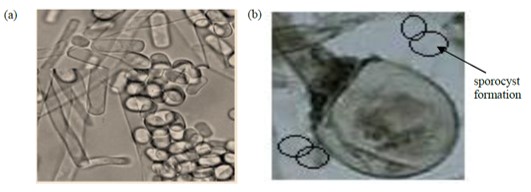In Vitro Removal of Electronic and Electrical Wastes by Fungi Isolated from Soil at Annaba Area in Northeast of Algeria 10.32526/ennrj/19/2020294
Main Article Content
Abstract
Electronic and electrical wastes (EEW) have increased exponentially in recent years due to technological progress. The uncontrolled incineration of these wastes causes pollution of air, soil, and water that has dangerous effects on health of human beings and other living organisms. This work isolated fungi that are capable of degrading some of these electronic wastes. In this study, fungi isolated from soil polluted by EEW were grown on potatoes dextrose agar (PDA) medium. The estimation of the biodegradation was achieved by inoculation of both rechargeable batteries and printed circuit boards on a minimum solid and liquid medium with selected fungal strains. During the process of biodegradation on solid medium, microscopic observation was done, and on liquid medium the production of keratinolytic enzymes was evaluated using a colorimetric method after incubation with keratine powder. After 30 days, the obtained results showed that Geotrichum candidum is capable of degrading battery and circuit boards with rates of 23% and 71%, respectively, while Rhizopus stolonifer reduced battery weight by 7% and printed circuit boards by 60%. Microscopic observations showed no morphological modification in Geotrichum candidum, while there was sporocyst formation in Rhizopus stolonifer. The detection of enzymatic production indicated that there is a relation between the biodegradation process of electronic wastes and keratinolytic enzymes in Geotrichum candidum.
Article Details
Published articles are under the copyright of the Environment and Natural Resources Journal effective when the article is accepted for publication thus granting Environment and Natural Resources Journal all rights for the work so that both parties may be protected from the consequences of unauthorized use. Partially or totally publication of an article elsewhere is possible only after the consent from the editors.
References
Aung KMM, Ting YP. Bioleaching of spent fluid catalytic cracking catalyst using Aspergillus niger. Journal of Biotechnology 2005;116(2):159-70.
Botton B, Breton A, Fevre M, Gauthier S, Guy P, Larpent JP. Useful and Harmful Mold: Importance Industrial (Moisissure Utiles et Nuisibles: Importance industrielle). Paris, France: Elsevier Masson; 1990. p. 11-190.
Bourzama G, Ennaghra N, Soumati B, Benoune S, Atriche N. Effect of zinc metal at high concenetration on secondary metabolic pathways in Penicillium chrysogenum strain. Journal of Microbiology, Biotechnology and Food Sciences 2019;9(2):307-13.
Brandl H, Bosshard R, Wegmann M. Computer-munching microbes: Metal leaching from electronic scrap by bacteria and fungi. Hydrometallurgy 2001;59:319-26.
Brunner I, Fischer M, Ruthi J, Stierli B, Frey B. Ability of fungi isolated from plastic debris floating in the shoreline of a lake to degrade plastics. PLOS ONE 2018;13(8):e0202047.
Ceci A, Kierans M, Hillier S, Persiani AM, Gadd GM. Fungal bioweathering of mimetite and a general geomycological model for lead apatite mineral biotransformations. Applied and Environmental Microbiology 2015;81:4955-64.
Clark EM, White JF, Patterson RM. Improved histochemical techniques for the detection of Acremonium coenophialum in tall fescue and methods of in vitro culture of the fungus. Journal of Microbiology Methods 1983;1:149-55.
Cui J, Zhang L. Metallurgical recovery of metals from electronic waste: A review. Journal of Hazardous Materials 2008;58: 228-56.
Cunningham JA, Harwood V. Fungi recycle rechargeable lithium-ion batteries. American Chemical Society [Internet]. 2016 [cited 2020 Aug 21]. Available from: https:// www.sciencedaily.com/releases/2016/08/160821093037.htm.
Dave SR, Sodha AB, Tipre DR. Microbial technology for metal recovery from e-waste printed circuit boards. Journal of Bacteriology and Mycology 2018;6(4):241-7.
De Reu JC, Rombouts FM, Nout MJR. Influence of acidity and initial substrate temperature on germination of Rhizopus oligosporus sporangiospores in tempe fermentation. Journal of Applied Bacteriolology 1995;78:200-8.
Gaddeyya G, Niharika PS, Bharathi P, Kumar PKR. Isolation and identification of soil mycoflora in different crop fields at Salur Mandal. Advances in Applied Science Research 2012;3:2020-6.
Gavilán-García A, Román-Moguel A, Almada-Calvo F, Aburto-Mejía S. Electronic waste generation and technology for an appropriate management in México. Boletín de la Sociedad Química de México 2009;3(2):85-92.
Hall WJ, Williams PT. Processing waste printed circuit boards for material recovery. Circuit World 2007;33:43-50.
Huang K, Guo J, Xu Z. Recycling of waste printed circuit boards: A review of current technologies and treatment status in China. Journal of Hazardous Materials 2009;164:399-408.
Kubicek CP, Mikus M, Schuster A, Schmoll M, Seiboth B. Metabolic engineering strategies for the improvement of cellulose production by Hypocrea jecorina. Biotechnology Biofuels 2009;2:19.
Mozos EA, Bilbao AR, Díaz-Martín F. WEEE Recycling and circular economy assisted by collaborative robots. Applied Science 2020;10(14):4800.
Muthu SS. Roadmapto Sustainable Textiles and Clothing: Environmental and Social Aspects of Textiles and Clothing Supply Chain. New York, USA: Springer Singapore; 2014.
Nakajima-Kambe T, Shigeno-Akutsu Y, Nomura N, Onuma F, Nakahara T. Microbial degradation of polyurethane, polyester polyurethanes and polyether polyurethanes. Applied Microbiology and Biotechnology 1999;51(2):134-40.
Navaneethakrishnan V, Pavithra K, Vanitha V. Recycling of lithium ion batteries using fungi based organic acids. Materials Science and Engineering 2020;872:12-3.
Internship report IUT. Nîmes on Study of the biodegradation of biodegradable polymers (Etude de la biodégradation de polymères biodégradables). Paris, France: Ecole des Mines d’Alès; 2013.
Pochon J, Tardieux P. Soil microbiology analysis technique (Technique d’analyse en microbiologie du sol). Edition of Tourtourelle. France: Saint-Mandé; 1962.
Schaffner DW, Toledo RT. Cellulase production by Trichoderma reesei when cultured on xylose-based media supplemented with sorbose. Biotechnology and Bioengineering 1991;37:12-6.
Sodhi MS, Reimer B. Models for recycling electronics end-of-life products. OR Spektrum 2001;23:97-115.
Sum E. The recovery of metals from electronic scrap. Journal of
Metallurgy 1991;43:53-61.
Szałatkiewicz J, Szewczyk R, Budny E, Missala T, Winiarski W. Measurement and control system of the Plasmatron Plasma reactor for recovery of metals from printed circuit board waste. Advanced Intelligent 2014;267:687-95.
Takiuchi I, Higuchi D, Sei Y, Koga M. Isolation of an extracellular proteinase (keratinase) from Microsporum canis. Sabouraudia 1982;20:281-8.
Tomer A, Singh R, Singh SK, Dwivedi SA, Reddy CU, Keloth MRA, et al. Role of Fungi in Bioremediation and Environmental Sustainability. Switzerland: Springer Nature; 2020. p.1-20.
Wackett LP, Hershberger CD. Biocatalysis and Biodegradation: the Microbial Transformation of Organic Compounds. Washington, USA: ASM Press; 2001.
Weidenhamer JD, Clement ML. Leaded electronic waste is a possible source material for lead-contaminated jewelry. Chemosphere 2007;7:1111-5.

